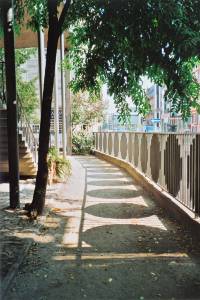Hortus, 2005-2006
Weißfrauen Diakoniekirche
Kuratiert von Gerald Hintze
Frankfurt am Main
Associations of a quite different era are to be found in hortus, an outdoor installation attached to the Fifties architecture of a church in Frankfurt. Emerging from a heavily frequented road-tunnel, you notice hortus in passing, as the Weissfrauenkirche is squeezed onto the edge of a broad thoroughfare that bisects an entire district and turns it into a social flashpoint. The church, whose centuries-old history is now attested to only by a small number of old gravestones, is surrounded by a fence like enclosure as if it were a monastery.
Protto's intervention transforms the visible courtyard area into an enclosed garden, a hortus conclusus, such as was part of Medieval monastery grounds. The motif of the garden is expressed in hortus in abstract shapes: a long series of wooden discs painted white in the horizontal rods of the fence block the space off on the side facing the road, while emulating architectural elements of the church itself, causing the entire church building to function like a sounding board, a body lent a clear rhythm. Moreover you might also imagine you are seeing large metal discs that you can bang like gongs when walking past them. Likewise you might associate these round discs in the newly created enclosure with the geometric shapes of carefully trimmed box trees, yew bushes and cypresses – after the abstracting designs drawn by Baroque landscape gardeners.
After all, the monastery garden created by this new enclosure offers protection and transforms the otherwise inhospitable area.
Even without using natural materials, with the architectural garden at the Weissfrauenkirche Christiana Protto has once again addressed her theme of the related principles of art and nature.
Iris Reepen, 2006

